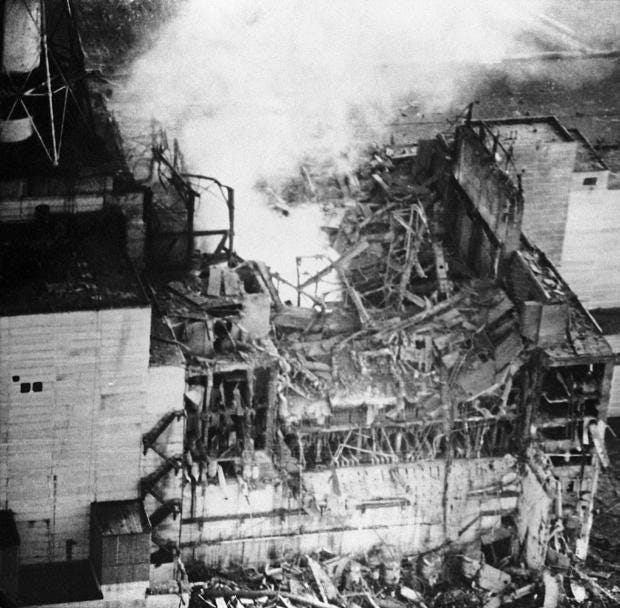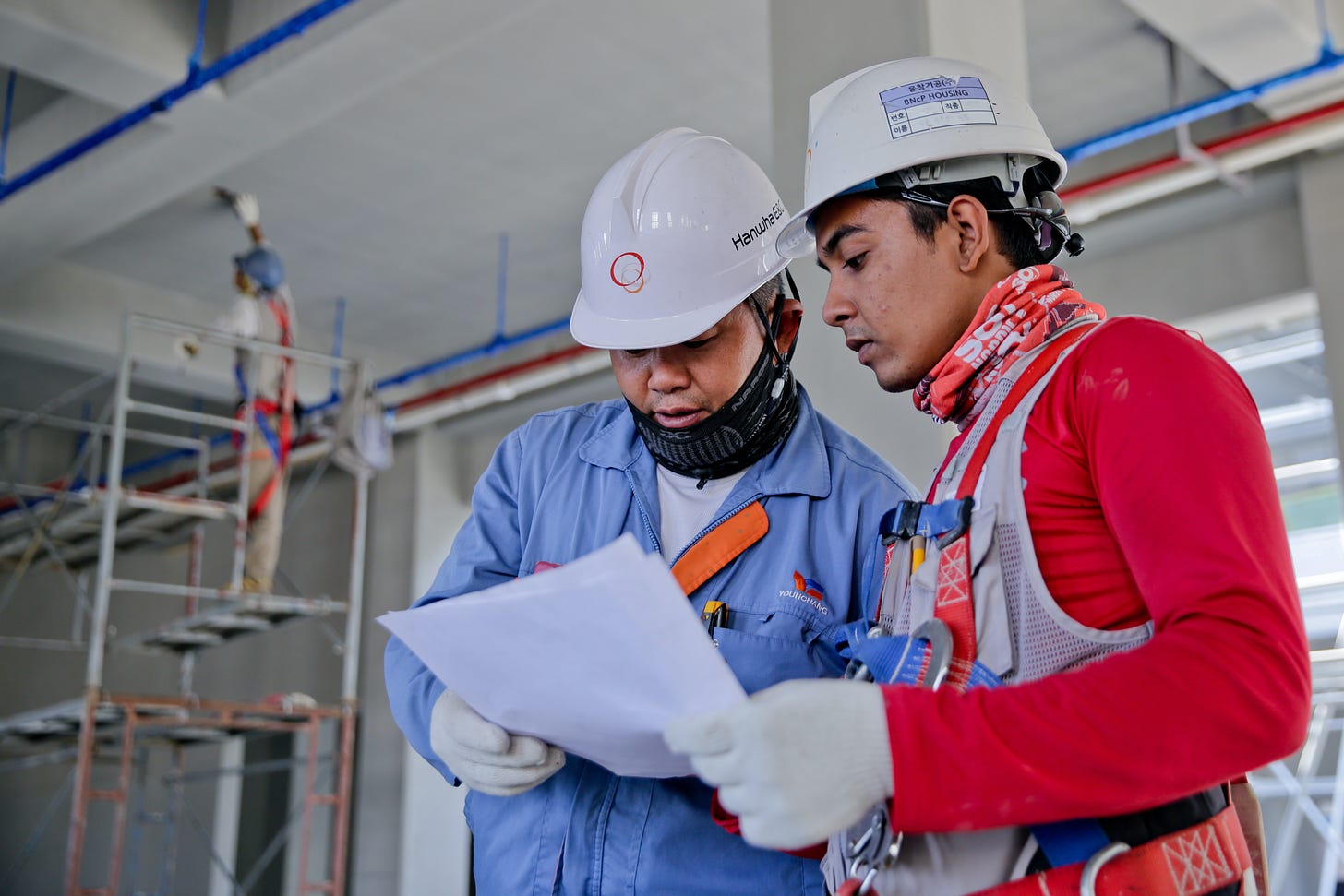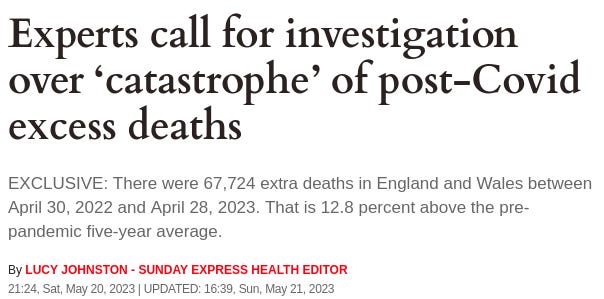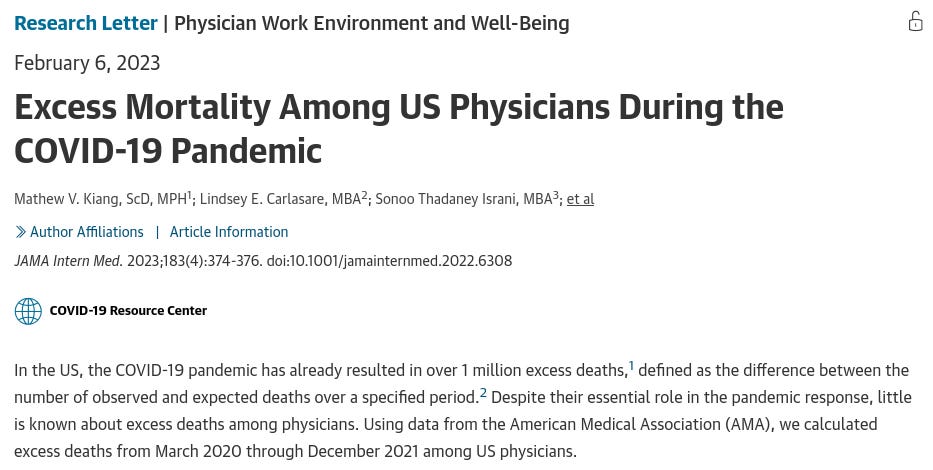One use for nuclear energy is to generate electricity from thermal energy.
All forms of electrical generation carry safety risks due to the scale of energy under control. e.g., A dam that diverts the mass flow of a river carries a large risk to the public if the dam fails. Nuclear energy is no different.
There have been several nuclear accidents over the years, but Chernobyl like no other captured the hearts and minds of the masses. Chernobyl was a nuclear power station in the Soviet Union located 104 km north of Kyiv, Ukraine, which consisted of four 1,000 MW units.1 The accident occurred in 1986 during an experiment, where the reactor regulating system and emergency safety systems were disabled at 7% power.
The core went super critical resulting in over-pressurization. A heavy concrete and steel lid was blown off, which subsequently spread large amounts of radioactive material into the area and atmosphere. Analyses of the accident have contributed to many nuclear safety standards and modern operational guidelines.
Before Chernobyl, there was the accident at Three Mile Island in 19792 and more recently Fukushima in 20113.
All accidents have served to enhance to nuclear safety standards.
After the accident at Three Miles Island, the Institute of Nuclear Power Operations (INPO) was formed in Dec. 1979 in response to the Kemeny Commission’s recommendations. Likewise, the World Association of Nuclear Operators (WANO) was formed after the Chernobyl accident in 1986.4
INPO offers on-site plant evaluations, scores, guidelines and recommendations. Guidelines are prepared and reviewed by nuclear safety experts using Operating Experience (OPEX) and accident analyses. One of their guideline documents is titled Pocket Guide to INPO 12-012: Traits of a Healthy Nuclear Safety Culture.
The guideline specifies 10 traits of a healthy nuclear safety culture.5
(The first three are listed out.)
Personal Accountability.
Individuals at all levels hold themselves to the highest standards.
Individuals understand and demonstrate personal responsibility.
Individuals communicate and coordinate within and across organizations.
Questioning Attitude.
Individuals understand that complex technologies can fail in unpredictable ways.
Individuals stop when faced with uncertain conditions.
Individuals challenge assumptions and offer opposing views when they think something is not correct.
Individuals recognize and plan for the possibility of mistakes, latent problems, and inherent risk, even while expecting successful outcomes.
Effective Safety Communication.
Individuals incorporate safety communications in work activities.
Leaders ensure that the bases for operational and organizational decisions are communicated in a timely manner.
Individuals communicate openly and candidly, both up, down, and across organizations.
Leaders frequently communicate and reinforce the expectation that safety is the overriding priority.
Leadership Safety Values and Actions.
Leaders demonstrate a commitment to safety through decisions and behaviour.Decision-Making.
Safety decisions are systematic, rigorous and thorough.Respectful Work Environment.
Differing opinions are encouraged, discussed and resolved.Continuous Learning.
Opportunities to learn and train are sought out and encouraged.Problem Identification and Resolution.
Issues affecting safety are promptly identified, evaluated and addressed.Environment for Raising Concerns.
People feel free to raise safety concerns without fear of retaliation, intimidation, etc.Work Processes.
A process of planning and controlling acitivites is implemented with a safety mindset.
There are 3 industries that have the highest public safety requirements:
Nuclear.
Fission product release or radiological contamination can impact public safety.Aerospace.
Malfunction or operation error may impact flight safety or public safety.Biomedical.
Devices or pharmaceuticals may have negative efficacy and affect public safety.
As a best practice, safety related guidance from other fields should be reviewed for relevance during technical analyses. This is true for nuclear safety projects, where a selected analysis of aerospace or biomedical standards may provide additional quality assurance for a given project deliverable. (Ask me how I know…)
Likewise, we can imagine that the biomedical and aerospace fields would adopt a similar approach and review select nuclear safety guidelines for relevance.
Of course, Traits of a Healthy Nuclear Safety Culture is generic enough for any field.
Now, let’s examine a few pieces of information.
Pilot deaths
Pilot Incapacitation Events seem to have been receiving extra attention. We at US Freedom Flyers have been collaborating with Dr Makis on Pilot Incapacitation Event data (Covid Intel).
Each event is news and noteworthy, but is the number of Pilot Incapacitation Events in 2023 actually on track to exceed historical averages? While we certainly hope this is not the case, the current data should be examined against the available statistics.
— Historical context for Pilot Incapacitations, Mirthless Perspectives6
These are the 5 most recent pilot deaths according to Dr. William Makis.
[Pilot death - May 3, 2023 - Air Transat and former Air Canada pilot Eddy Vorperian, age 48, from Montreal, Canada, died suddenly]
Pilot death - March 17, 2023 - 39 year old Westjet Pilot Benjamin Paul Vige died suddenly in Calgary
Pilot death - March 11, 2023 - British Airways pilot died of heart attack in crew hotel in Cairo before a Cairo to London flight (name & age not released)
— Pilot died - Air Transat and former Air Canada pilot Eddy Vorperian, age 48, from Montreal, Canada, died suddenly on May 3, 2023 - 5th recent pilot death, Dr. William Makis7
According to the analysis done by Mirthless Perspectives, there is a historical expectation of 1 cardiac event per year. However, extrapolating from 2023 data there is a prediction of 1 pilot incapacitation every 40 days (roughly a 9x increase).
Excess deaths
Of course these concerns with pilot fitness are a microcosm for a much broader issue.
Unexpected deaths are more than 10 percent higher than the pre-Covid average, with experts warning we are facing “a catastrophe of equal proportion to the pandemic itself”.
— Experts call for investigation over ‘catastrophe’ of post-Covid excess deaths (May 20, 2023)
In the US, the COVID-19 pandemic has already resulted in over 1 million excess deaths, defined as the difference between the number of observed and expected deaths over a specified period. Despite their essential role in the pandemic response, little is known about excess deaths among physicians.
— Excess Mortality Among US Physicians During the COVID-19 Pandemic (Feb. 6, 2023)
This conclusion of accidental, if any, effectiveness is consistent with the data presented in the CMAJ paper, discussed above. It quite markedly indicates that for most of the time in most provinces, government measures contributed to the excess death count. In plain language, the government response to Covid-19 got people killed.
— Did the Virus or Governments Kill More Canadians? A Statistical Analysis of Excess Deaths during the Pandemic (Jan. 31, 2023)
I must say, there is a deafening silence from the Safety Culture experts.
Because Safety Culture has been replaced by a Safety Cult.
Do the Traits of a Healthy Nuclear Safety Culture conflict with the Safety Cult?
Have issues affecting safety been promptly identified, evaluated and addressed?
Do people feel free to raise safety concerns without fear of retaliation, intimidation, etc.?
Are safety decisions systematic, rigorous and thorough?
Are differing opinions encouraged, discussed and resolved?
The list goes on…
Complex technologies can fail in unpredictable ways, and we should stop and ask questions when faced with uncertain conditions.
From my observations, these are tenets of the modern Safety Cult.
NO Personal Accountability.
NO Questioning Attitude.
NO Effective Safety Communication.
NO Leadership Safety Values and Actions.
NO Decision-Making.
NO Respectful Work Environment.
NO Continuous Learning.
NO Problem Identification and Resolution.
NO Environment for Raising Concerns.
NO Work Processes.
I am well versed in the Traits of a Healthy Nuclear Safety Culture.
And I know I am not the only one.
Negligence in the practice of professional engineering means the failure to behave with the standard of care that a professional engineer of ordinary prudence would have exercised under the same circumstances. The behavior usually consists of actions, but can also consist of omissions when there is some duty to act.8
“Those who would give up essential liberty to purchase a little temporary safety,
deserve neither liberty nor safety.”
We didn't learn our lesson from Chernobyl.
To those who have taken a fearful vow of silence at the alter of the Safety Cult,
By biting your tongue, you have covered your eyes and avoided the horrors of today.
But now you are blind to the horrors of tomorrow.
There is a timeless demon of the black sun, who goes by many names.
A fang from the Angel of Death, foolishly worshipped by the totalitarian Safety Cult,
He devours bodies, hearts and minds; Of men, of women, and of your children.
And for the sake of your comfort, and born out of your fear,
You have invited it here.
May God have mercy on our souls.
Respectfully,
The Editors of Encyclopedia Britannica. (2023). Chernobyl disaster. In Encyclopedia Britannica. https://www.britannica.com/event/Chernobyl-disaster
The Editors of Encyclopedia Britannica. (2023a). Three Mile Island accident. In Encyclopedia Britannica. https://www.britannica.com/event/Three-Mile-Island-accident
The Editors of Encyclopedia Britannica. (2023b). Fukushima accident. In Encyclopedia Britannica. https://www.britannica.com/event/Fukushima-accident
INPO. (2023). INPO: Our History. https://inpo.info/
INPO. (2012). Pocket Guide to INPO 12-012: Traits of a Healthy Nuclear Safety Culture.
Mike. (2023, May 22). Historical context for pilot incapacitations. Mirthless Perspectives. https://mirthlessperspectives.substack.com/p/historical-context-for-pilot-incapacitations
Makis, W. (2023, May 15). Pilot died - Air Transat and former Air Canada pilot Eddy Vorperian, age 48, from Montreal, Canada, died suddenly on May 3, 2023 - 5th recent pilot death. COVID Intel - by Dr.William Makis. https://makismd.substack.com/p/pilot-died-air-transat-and-former
Le, C. N. (2019). Determining negligence in engineering failures. Cedengineering.com. https://www.cedengineering.com/userfiles/Determining%20Negligence%20in%20Engineering%20Failures%20Study%20Guide.R2.pdf









Looks like a great read, totally going to read this when the day slows down later 😁
I like the dry tone of the person discussing pilot deaths, even though it makes it harder to read.
Precision, free from emotion, is far more persuasive to certain kinds of thinkers.